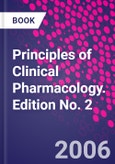Table of Contents
1. Introduction
PART 1: PHARMACOKINETICS 2. Clinical pharmacokinetics 3. Compartmental analysis of drug distribution 4. Drug absorption and bioavailability 5. Effects of renal disease on pharmacokinetics 6. Kinetics of hemodialysis and hemofiltration 7. Effects of liver disease on pharmacokinetics 8. Noncompartmental vs. compartmental approaches to pharmacokinetic analysis 9. Distributed models of drug kinetics 10. Population pharmacokinetics
PART 2: DRUG METABOLISM AND TRANSPORT 11. Pathways of drug metabolism 12. Biochemical mechanisms of drug toxicity 13. Chemical assay of drugs and drug metabolites 14. Equilibrative and concentrative transport 15. Pharmacogenetics 16. Drug interactions
PART 3: ASSESSMENT OF DRUG EFFECTS 17. Physiological and laboratory markers of drug effect 18. Dose response and concentration response analysis 19. Kinetics of pharmacologic effect 20. Disease progression models
PART 4: OPTIMIZING AND EVALUATING PATIENT THERAPY 21. Sex differences in pharmacokinetics and pharmacodynamics 22. Drug therapy in pregnant and nursing women 23. Drug therapy in neonates and pediatric patients 24. Drug therapy in the elderly 25. Clinical analysis of adverse drug reactions 26. Quality assessment of drug therapy
PART 5: DRUG DISCOVERY AND DEVELOPMENT 27. Project management 28. Drug discovery 29. Pre-clinical development 30. Animal scale up 31. Phase I studies 32. PK and PD considerations in the development of biotechnology products and large molecules 33. Design of clinical development programs 34. Good design practices for clinical trials 35. Role of the FDA in guiding drug development
Appendix I. Table of Laplace Transforms II. Answers to Study Problems








